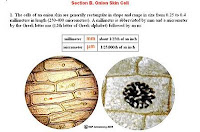Did You Know?
Terima kasih Pengunjungku :

Friday, December 11, 2009

Contained within the cytoplasm are not only the nucleus but also organelles, whose specific functions help the cell perform a range of activities.
While plant and animal cells are similar, the plant cell has, in addition to the cell membrane, another boundary that separates it from its external environment. This is called the cell wall.
As most plant cells carry out photosynthesis - the synthesis of organic substances - they contain chloroplasts.
In the laboratory, you have learned how to prepare a microscope slide of human cheek cells as well as the epidermal cells of onions.
a) The differences you can observe between the two types of cells in term of the following:
* Shape
Onion cells have a regular shape while cheek cells have an irregular shape.
* Presence or absence of cell wall
Onion cells have a cell wall while cheek cells do not.
Onion cells have a large vacuole while vacuoles in cheek cells, if present, are small.
No chloroplasts can be observed in the epidermal cells of onions because epidermal cells do not carry out photosynthesis.
Source :
- http://www.diffen.com/difference/Animal_Cell_vs_Plant_Cell
- http://cikgunaza.blogspot.com/2009/04/biology-form-4-cell.html
2 Comments:
-
- Dunia Ifat said...
December 14, 2009 at 7:37 PMduh pake bahasa inggris nih bu, jadi puyeng- Emilia SP said...
December 20, 2009 at 10:36 AM@Ifat : gpp kok ..sy dulu juga sering puyeng klo hrs baca literatur in english..lama2 juga ntar dah biasa puyengnya..hahaha...



















